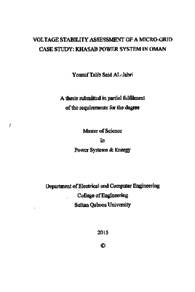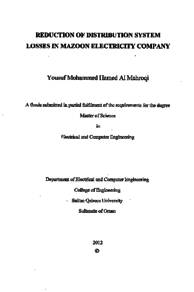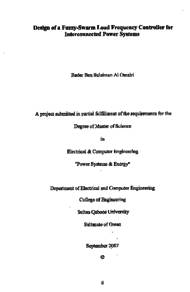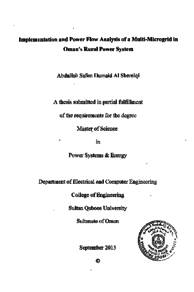Document
Design of a fuzzy logic power system stabilizer for the main interconnected power system of Oman
Publisher
Sultan Qaboos University
Gregorian
2015
Language
English
English abstract
Power systems are subjected to low-frequency disturbances that might cause loss of synchronism and eventually might lead to blackouts. The oscillations, which are typically in the frequency range of 0.2 to 3.0 Hz, might be excited by the disturbances in the system or, in some cases, might even build up spontaneously. These oscillations limit the power transmission capability of a network and, sometimes, even cause a loss of synchronism and an eventual breakdown of the entire system. To mitigate this, Power system stabilizers (PSS) are used to generate supplementary control signals for the excitation system in order to damp these low frequency power system oscillations. Previous studies show that Oman Main Interconnected System (Oman-MIS) experienced low frequency oscillations that might affect the system's stability. The existence of a lightly-damped low frequency oscillations was observed across many geographical locations in Oman after a three-phase short circuit fault occurred on a 132 kV transmission line. Furthermore, the system is now expanded and have three main voltages for the transmission network: 400kV, 220kV and 132kV. Therefore, it is advisable to investigate the low frequency oscillations in the upgraded network and propose solutions to overcome such oscillations. The main objective of this research is to design a fuzzy logic controller (FLC) for OmanMIS to damp unpredicted oscillations. Unlike the Conventional Power System Stabilizers (CPSS), the fuzzy logic controller design does not need exact mathematical equations of the system. It just depends on some logic rules, IF-THEN rules, which use the linguistic knowledge of system's operator. In order to compare performance, two PSS's were designed: a CPSS was designed using frequency-response approach, and a fuzzy logic PSS (FLPSS) was designed based on normalized membership functions and linguistic rules. Then, the Oman Main Interconnected System (MIS) was modeled using MATLAB/Simulink extracted from a DIGSILENT model. The system performance for each PSS was achieved by simulating the whole system in MATLAB/Simulink environment. A three-phase short circuit fault was imposed in one of the 400kV bus bars. The built model of Oman-MIS in MATLAB/Simulink experienced severe low-frequency oscillations when there was no PSS installed on the generators. With the use of the CPSS only, light damping to the systems oscillations was observed. Whilst the proposed FLPSS had much better damping to those oscillations.
Member of
Resource URL
Arabic abstract
تتعرض أنظمة الطاقة لاضطرابات ذات ترددات منخفضة تتسبب أحيانا في فقدان التزامن وقد تؤدي في النهاية إلى انهيار منظومة الكهرباء، فقد تستثار الذبذبات التي تكون عادة في نطاق التردد 0.2 – 3. 0 هرتز، بالاضطرابات الحادثة في النظام، كما أنها قد تتزايد من تلقاء نفسها في حالات أخرى. تحت هذه الذبذبات من قدرة نقل الطاقة في الشبكة كما تسبب في بعض الأحيان فقدان التزامن قد ينتهي بتعطل كامل للنظام. ولهذا الغرض يتم استخدام موازنات طاقة لتوليد إشارات تحكم تكميلية لنظام الإثارة للحد من ذبذبات التردد المنخفض في نظام الطاقة.
أوضحت دراسات سابقة أن شبكة عمان الرئيسة المرتبطة تتعرض لذبذبات تردد منخفض قد تؤثر على استقرار النظام. لوحظت ذبذبات ذات تردد منخفض مخففة التوهين على نطاق مواقع جغرافية عديدة في عمان بعد حدوث التماس كهربائي ثلاثي الأوجه في الشبكة 132 ك. ف. إضافة لذلك، فقد توسع النظام حاليا ليشمل ثلاث مجموعات فلطية لشبكة النقل: 400 ك.ف / 220 ك.ف / و: 132 ك.ف وبالتالي، أصبح من المطلوب تقصي مشكلة الذبذبات ذات التردد المنخفض في الشبكة المطورة واقتراح حلول للتغلب عليها.
يهدف هذا البحث إلى تصميم نظام تحكم في نظام شبكة عمان الرئيسة المرتبطة يعمل بتقنية المنطق الضبابي بغرض الحد من تأثير الذبذبات منخفضة الترددات والتي لا يمكن التنبؤ بحدوثها على وجه الدقة. وعلى غير نمط المثبتات التقليدية لنظام الطاقة، فإن نظام التحكم بتقنية المنطق الضبابي لا يحتاج إلى المعادلات الرياضية الجبرية التي صمم عليها النظام، بل يعتمد فقط على بعض القواعد المنطقية، أي قواعد (الشرط - جواب الشرط) التي تستخدم المعرفة اللغوية لمشغل النظام.
ولأجل مقارنة الأداء بين النظامين، تم تصميم مثبتين لنظام الطاقة، أحدهما مثبت تقليدي يستخدم أسلوب التردد والاستجابة، والأخر مصمم على أساس مجموعة عناصر الدوال المعبرة والقواعد اللغوية. ثم تم تصميم نموذج الشبكة عمان الرئيسة المرتبطة باستخدام برمجة المحاكاة التخطيطية النموذج الرقمي المتعدد (ماتلاب) مأخوذة من نموذج محاكاة رقمية وبرنامج حساب الشبكة الكهربائية. تم الحصول على أداء كل مثبت لنظام الطاقة بمحاكاة مجمل النظام في بيئة محاكاة تخطيطية بيئة نموذج رقمي متعدد (ماتلاب).
تم فرض التماس كهربائي ثلاثي الأوجه على أحد خطوط 400 ك. ف فأظهر النموذج المصمم لشبكة عمان الرئيسة المرتبطة تذبذبات حادة ذات ترددات منخفضة حال عدم تركيب مثبتات لنظام الطاقة. ثم اختبرت مثبتات نظام الطاقة، فحققت المثبتات التقليدية لنظام الطاقة توهينا ملحوظا للذبذبات بينما أعطت مثبتات نظام الطاقة بالمنطق الضبابي تعزيزا إضافيا لعملية توهين الذبذبات.
أوضحت دراسات سابقة أن شبكة عمان الرئيسة المرتبطة تتعرض لذبذبات تردد منخفض قد تؤثر على استقرار النظام. لوحظت ذبذبات ذات تردد منخفض مخففة التوهين على نطاق مواقع جغرافية عديدة في عمان بعد حدوث التماس كهربائي ثلاثي الأوجه في الشبكة 132 ك. ف. إضافة لذلك، فقد توسع النظام حاليا ليشمل ثلاث مجموعات فلطية لشبكة النقل: 400 ك.ف / 220 ك.ف / و: 132 ك.ف وبالتالي، أصبح من المطلوب تقصي مشكلة الذبذبات ذات التردد المنخفض في الشبكة المطورة واقتراح حلول للتغلب عليها.
يهدف هذا البحث إلى تصميم نظام تحكم في نظام شبكة عمان الرئيسة المرتبطة يعمل بتقنية المنطق الضبابي بغرض الحد من تأثير الذبذبات منخفضة الترددات والتي لا يمكن التنبؤ بحدوثها على وجه الدقة. وعلى غير نمط المثبتات التقليدية لنظام الطاقة، فإن نظام التحكم بتقنية المنطق الضبابي لا يحتاج إلى المعادلات الرياضية الجبرية التي صمم عليها النظام، بل يعتمد فقط على بعض القواعد المنطقية، أي قواعد (الشرط - جواب الشرط) التي تستخدم المعرفة اللغوية لمشغل النظام.
ولأجل مقارنة الأداء بين النظامين، تم تصميم مثبتين لنظام الطاقة، أحدهما مثبت تقليدي يستخدم أسلوب التردد والاستجابة، والأخر مصمم على أساس مجموعة عناصر الدوال المعبرة والقواعد اللغوية. ثم تم تصميم نموذج الشبكة عمان الرئيسة المرتبطة باستخدام برمجة المحاكاة التخطيطية النموذج الرقمي المتعدد (ماتلاب) مأخوذة من نموذج محاكاة رقمية وبرنامج حساب الشبكة الكهربائية. تم الحصول على أداء كل مثبت لنظام الطاقة بمحاكاة مجمل النظام في بيئة محاكاة تخطيطية بيئة نموذج رقمي متعدد (ماتلاب).
تم فرض التماس كهربائي ثلاثي الأوجه على أحد خطوط 400 ك. ف فأظهر النموذج المصمم لشبكة عمان الرئيسة المرتبطة تذبذبات حادة ذات ترددات منخفضة حال عدم تركيب مثبتات لنظام الطاقة. ثم اختبرت مثبتات نظام الطاقة، فحققت المثبتات التقليدية لنظام الطاقة توهينا ملحوظا للذبذبات بينما أعطت مثبتات نظام الطاقة بالمنطق الضبابي تعزيزا إضافيا لعملية توهين الذبذبات.
Category
Theses and Dissertations






